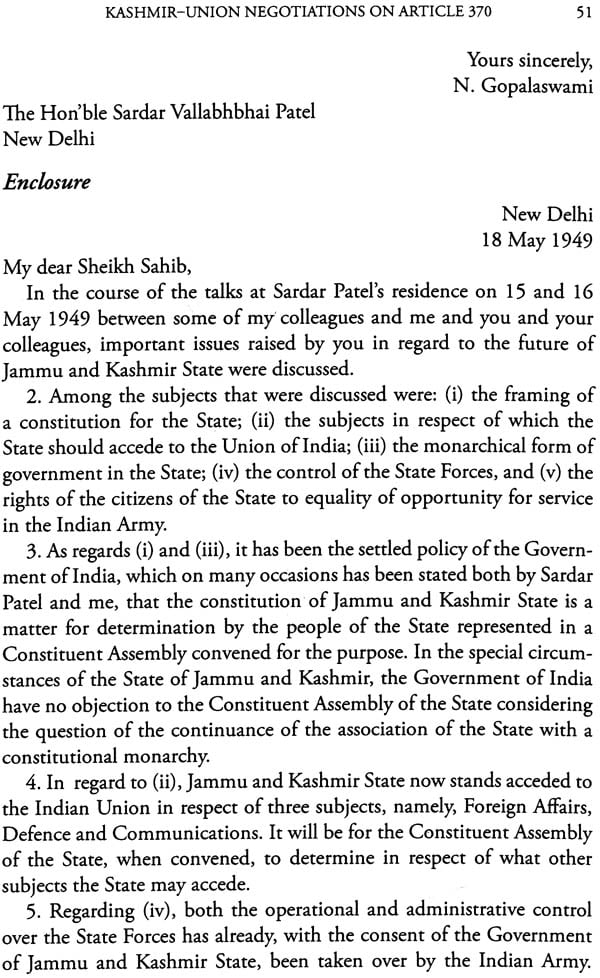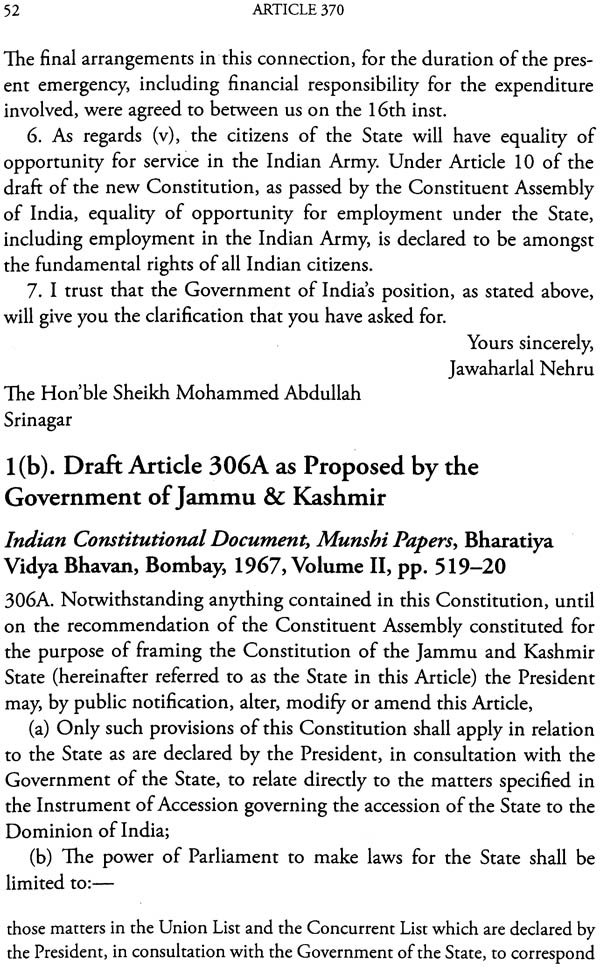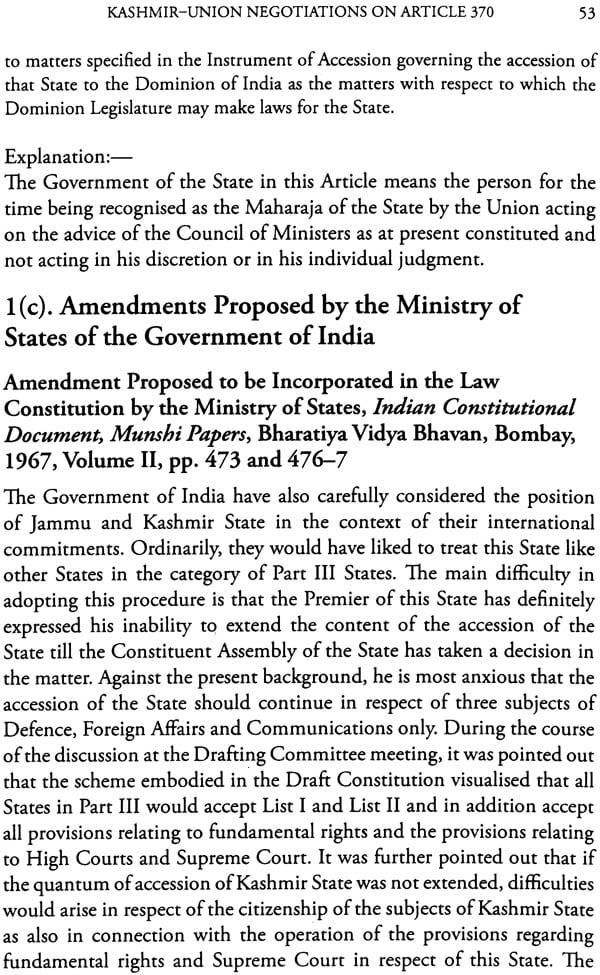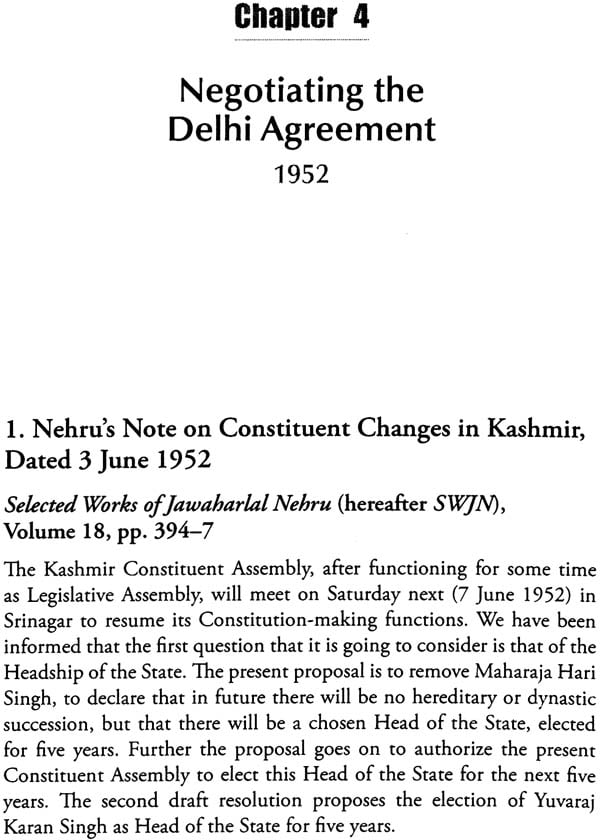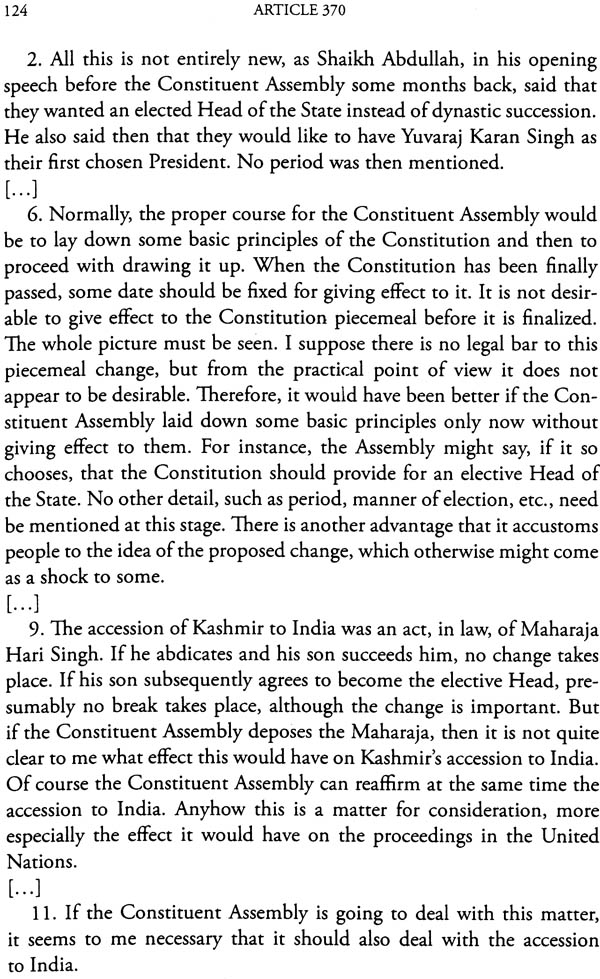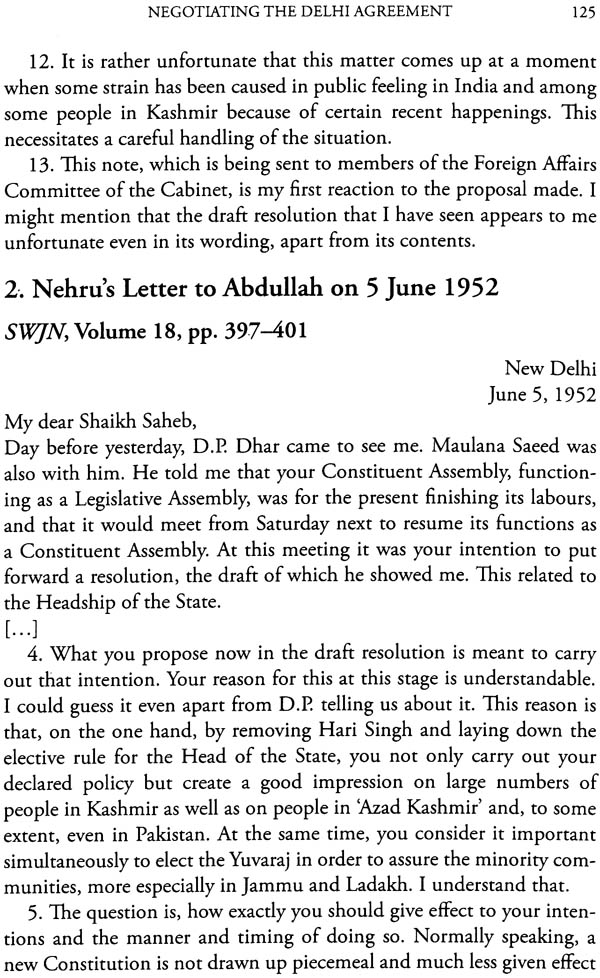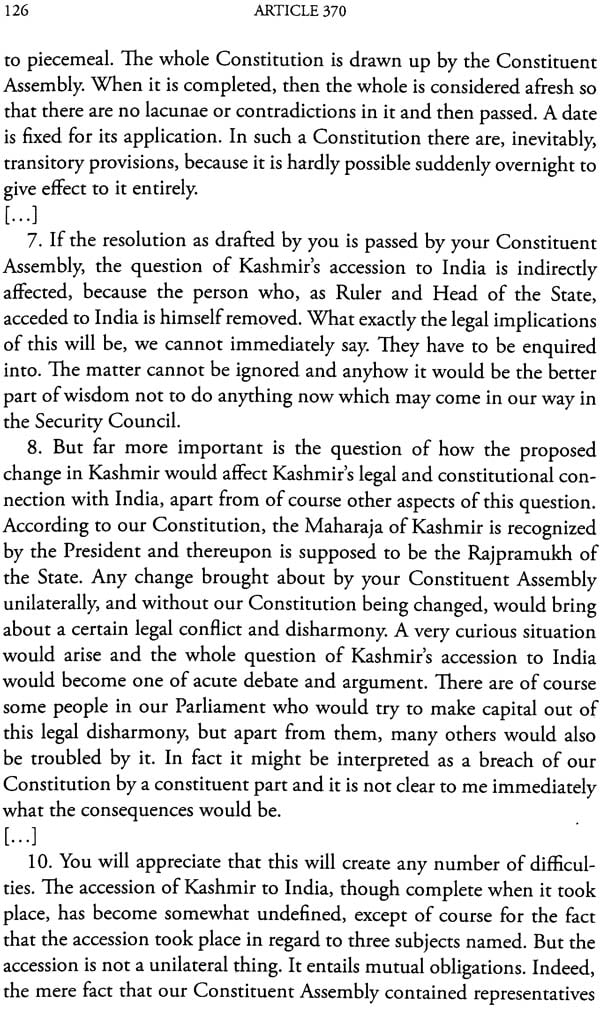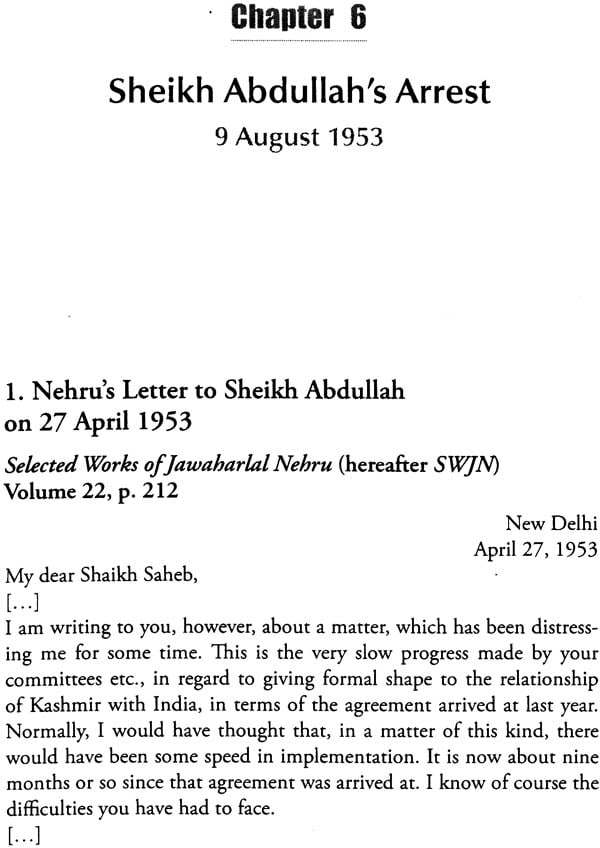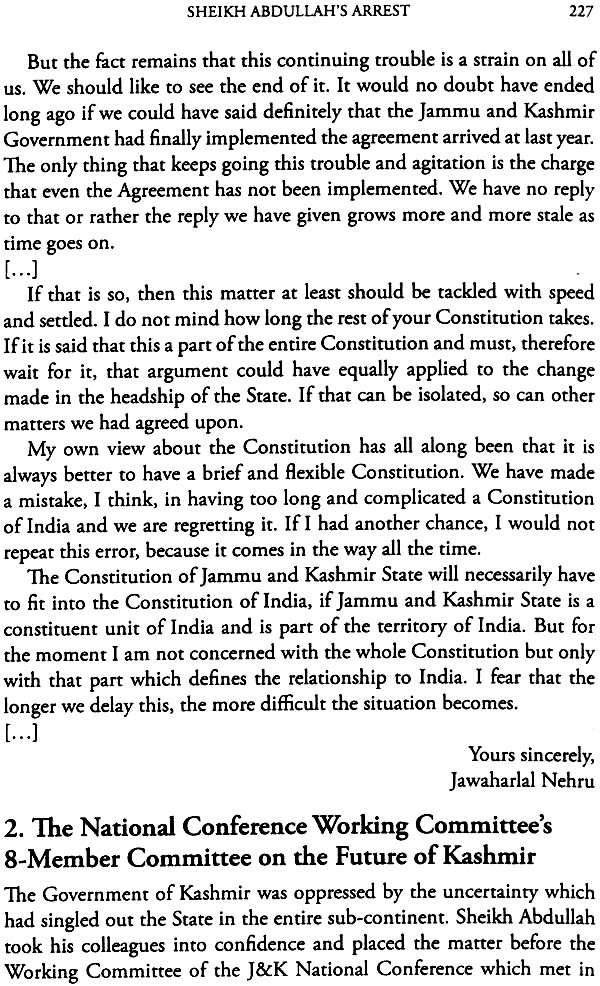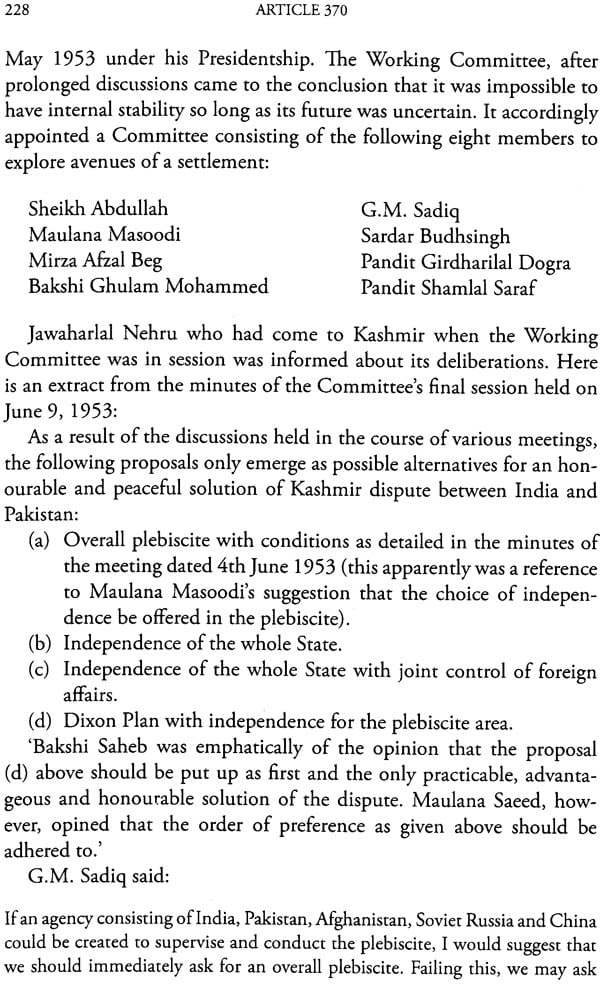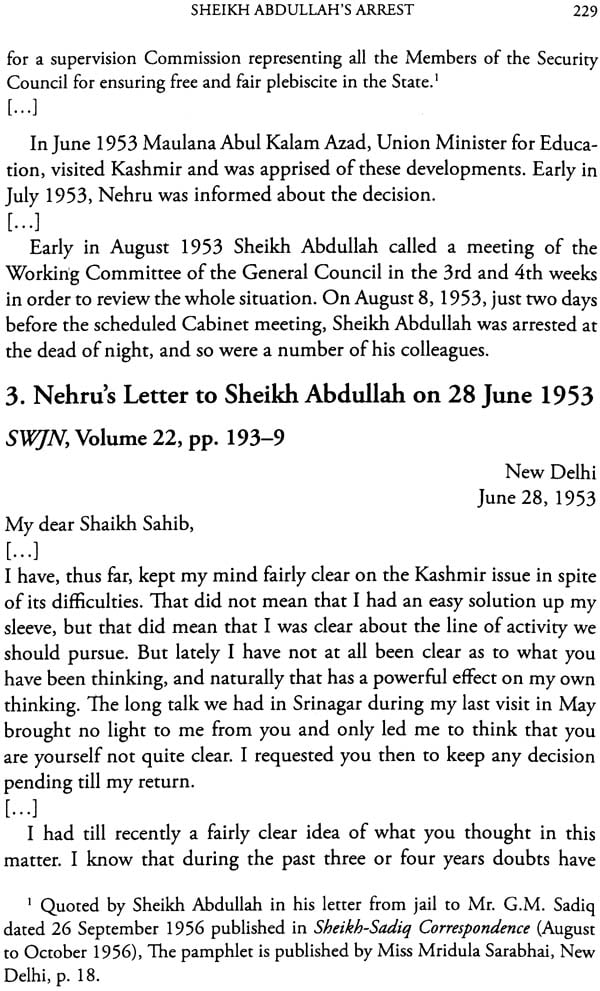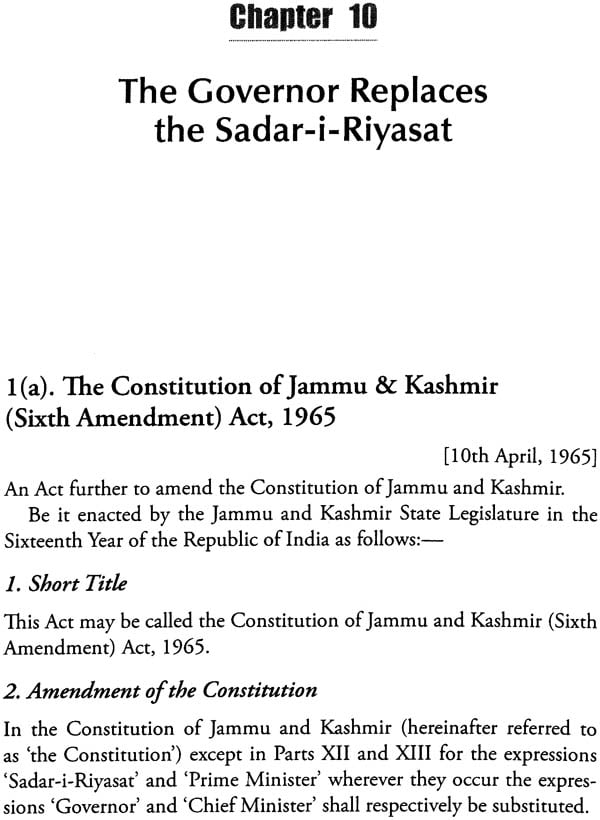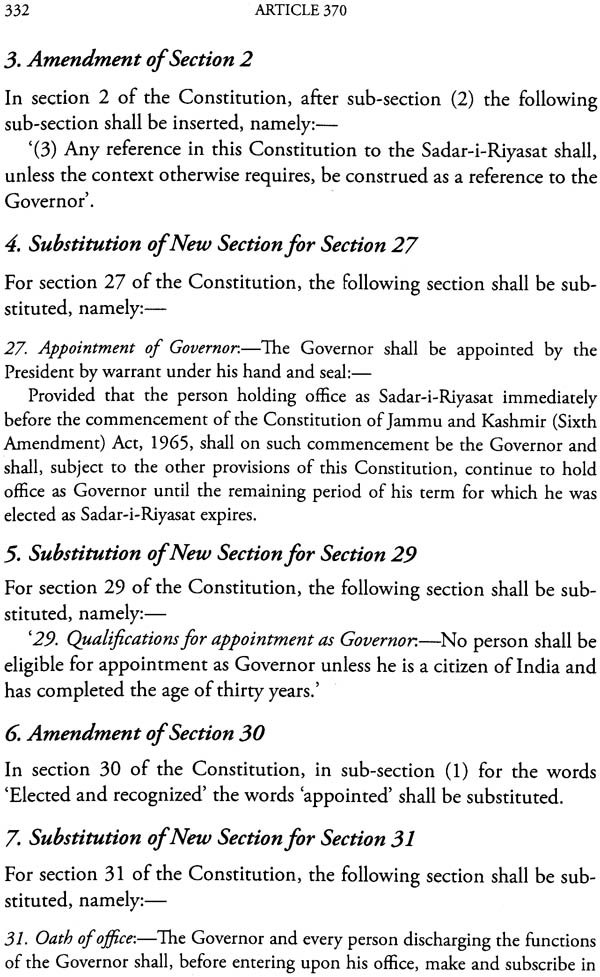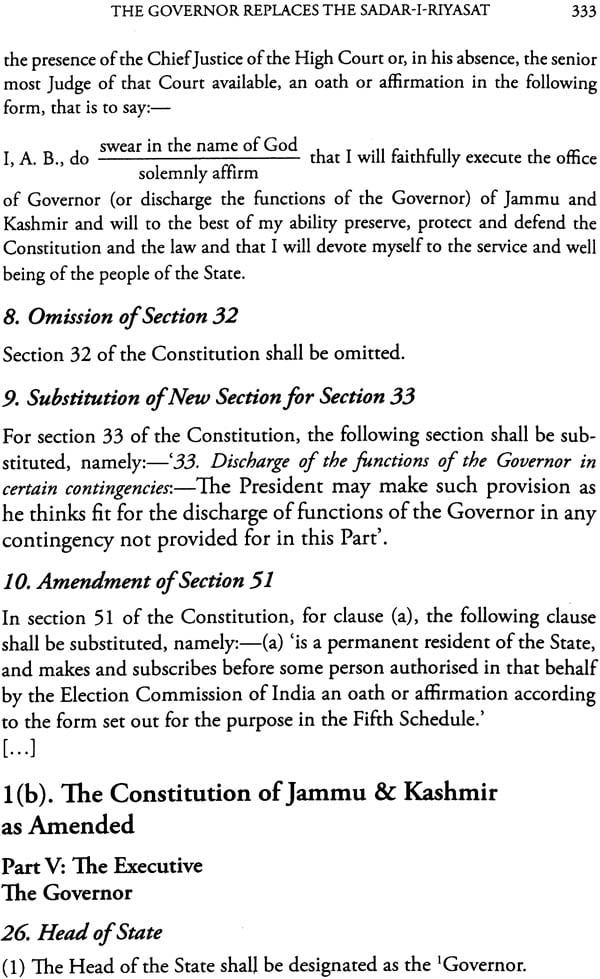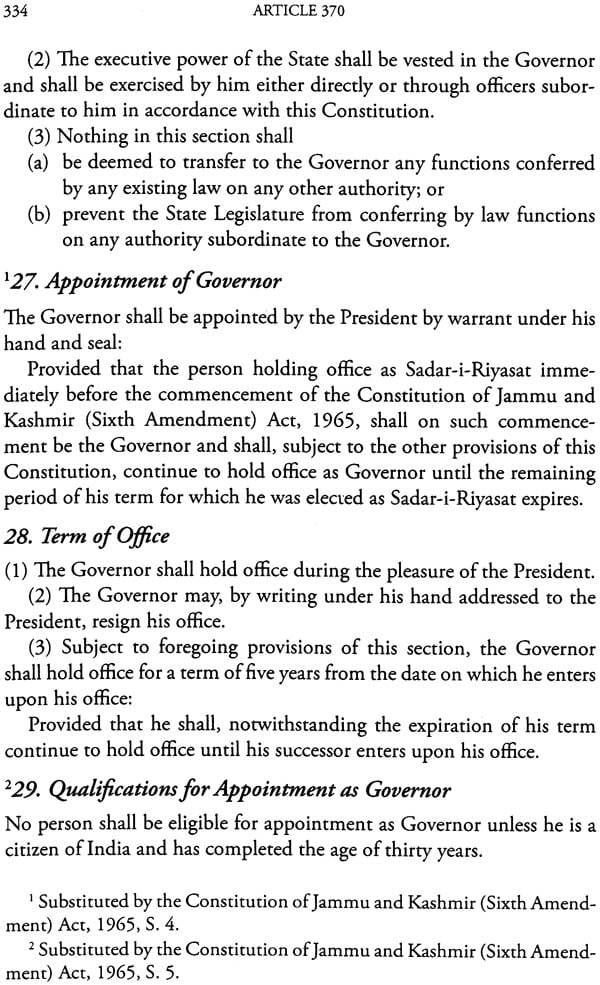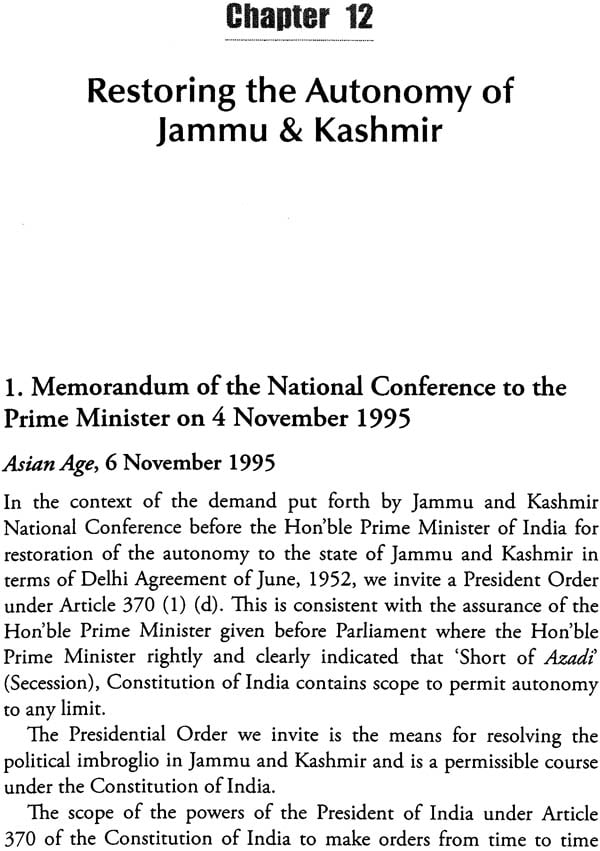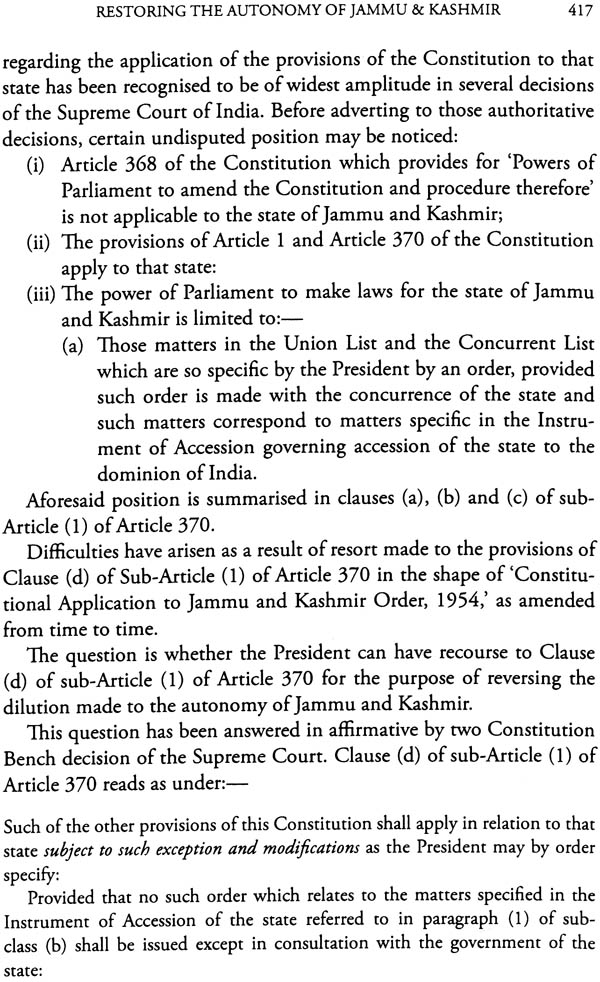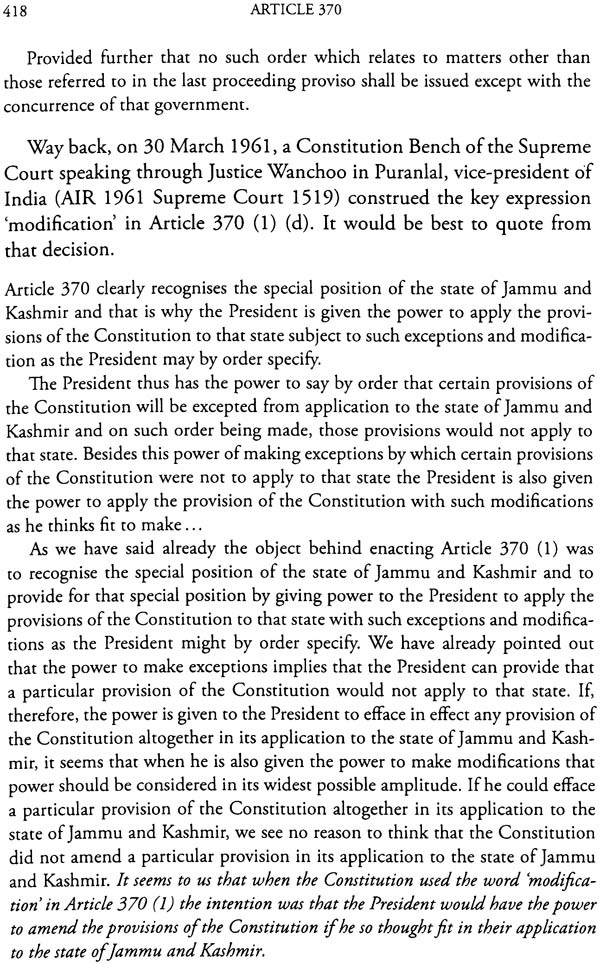
A Constitutional History of Jammu and Kashmir
Book Specification
| Item Code: | NAL809 |
| Author: | A.G. Noorani |
| Publisher: | Oxford University Press, New Delhi |
| Language: | English |
| Edition: | 2014 |
| ISBN: | 9780199455263 |
| Pages: | 503 |
| Cover: | Paperback |
| Other Details | 8.5 inch X 5.5 inch |
| Weight | 490 gm |
Book Description
Article 370 of the Constitution of India, which accorded ‘special status’ to the people of Jammu and Kashmir, is more than 60 years old. This article, which negotiated the terms of J&K’s membership with the Indian Union, and took over five months of discussion to come into being, is the author’s subject of scrutiny.
Alternating deftly between history and politics, this study examines the implications and consequences of Article 370 for the constitutional democracy of the state and the nation, and how it offered a ‘unique solution’ for resolving the ‘Kashmir problem’. From J&K’s accession to India in 1947 to present-day Kashmir, and collecting together rare and unnoticed letters, memoranda, proclamations, and amendments including presidential order under Article 370, this book documents the little-known constitutional history of the state.
A.G. NOORANI is a lawyer specializing in constitutional law and history. He is a columnist for Frontline and The Dawn. His recent publications include The Kashmir Dispute 1947-2012 (OUP, 2013), The Destruction of Hyderabad (2013), and Islam, South Asia & the Cold War (2012).
This collection of documents or Article 370 of the Constitution of India, which contains ‘temporary provisions’ with respect to the State of Jammu and Kashmir, provides documents on the five-month long negotiations which preceded its enactment on 17 October 1949; explains the significance of the article; describes how it was eroded, and traces the Constitutional evolution of the State and its relationship with the Union of India thereafter. It covers the period from 1946 to 2010.
The Third Group set up by the Prime Minister Dr Manmohan Singh, as a result of the three Round Table Conferences on Kashmir was devoted to this aspect. Justice Saghir Ahmad, a retired judge of the Supreme Court, drew up a report of this group. It is no more than a resume of various viewpoints expressed in the Conference by the political parties. All political parties. All political parties in Kashmir are agreed on the restoration of the State’s autonomy.
This, of course, requires qualification. The BJP’s Predecessor the Bhartiya Jan Sangh’s founder, Shyama Prasad Mookerjee, endorsed Article 370 when he was a member of the Union Cabinet. If he had considered it disruptive of national unity, he would have resigned from the Cabinet. In a letter of 4 February 1953 Sheikh Abdullah tellingly reminded Mookerjee “This arrangement (Art. 370) has not been arrived at now but as early as 1949 when you happened to be a part of the Government’ (Integrate Kashmir: Mookerjee-Nehru & Abdullah Correspondence, Publicity Department, Bhartiya Jan Sangh, P.37).
It is hoped that this collection of pertinent documents will assist in resolving the impasse on Article 370 and in providing a solution to the wider Kashmir problem. A draft of a revised Article 370, embodying proper safeguards, is included to assist in the discussions.
I would like to record my gratitude to Mr Iqbal Ganai, Secretary, Legislative Assembly of the State of Jammu and Kashmir for furnishing me with copies of the two volumes of the Official Record of the State’s Constituent Assembly and the Record of the Legislative of the Assembly debates on the Autonomy Report in 2000.
I am Particularly grateful to four Kashmiri friends for their invaluable assistance in this work. They are Mr Saifuddin Soz, former Union Minister, Mr Abdul Rahim Rather, Finance Minister in the Government of Jammu and Kashmir and the moving spirit behind the State’s Autonomy Committee, Mr Naeem Akhtar, Chief Spokesman of Jammu & Kashmir Peoples Democratic Party and Mr Iftikhar Gilani, Special Correspondent of the Tehelka group. Responsibility for the selection of documents is entirely mine.
Last but not least, I would like to thank my friends Mr Manzar Khan, Managing Director of Oxford University Press for his constant encouragement in the project and the interest he took throughout and Mr Shashank Sinha, Senior Commissioning Manager of Oxford University press for his enormous pains and editorial skills.
Article 370 of the Constitution of India relating to the state of and Kashmir is now sixty years old. The Constitution came into force on 26 January 1950 and with it, this unique provision. All other provisions were debated in the Constituent Assembly of India after deliberations in its Drafting Committee and, sometimes, discussions in the Congress Parliamentary Party.
Article 370 was discussed for five months by prime Minister of India, Jawaharlal Nehru and his colleagues with the Prime Minister of Jammu and Kashmir, Sheikh Mohammad Abdullah his colleagues; from May to October 1949 (Chapter 2, Doc. Nos 1-9). The State of Jammu and Kashmir is the only State in the Union of India which negotiated the terms of its membership with the Union. The Constituent Assembly merely put the imprimatur of its approval, on 17 October 1949, to a draft agreed between the Union and the State. Article 370 records a solemn compact. Neither side can amend or abrogate it unilaterally, except in accordance with the terms of that provision.
The Union Home Minister P. Chidambaram acknowledged in the Rajya Sabha on 6 August 2010 that Jammu and Kashmir had acceded to India in ‘unique circumstances;(Indian Express, 7 August 2010). He added that the State poses a ‘unique problem’ which requires a ‘unique solution’. It is not very evident, however, that the dimensions of the uniqueness and its implications are fully realized. It is one thing to say that ‘it is important to win the hearts and minds of the people of Jammu and Kashmir’. It is another to admit precisely what led to the grim situation which called for this resolve and to define realistically the measures which will accomplish the objective which the Minister mentioned
A little over a decade after the enactment of Article 370, its coarchitect, Prime Minister Nehru, declared in the Lok Sabha on 27 November 1963 that Article 370
Has been eroded, if I may use the word, and many things have been done in last few years which have made the relationship of Kashmir with the Union of India very close. There is no doubt that Kashmir is fully integrated… We feel that this process of gradual erosion of article 370 is going on. Some fresh steps are being taken and in the next month or two they will be completed. We should allow it to go on. We do not want to take the initiative in this matter and completely put an end to Article 370 (Chapter 9 , Doc. No.1).
There was no need for that, as the Union Home Minister Gulzari Lal Nanda explained in the Lok Sabha on 4December 1964: ‘the only way of tacking the Constitution (of India) into Jammu & Kashmir is through the application of Article 370… It is a tunnel. It is through this tunnel that a good deal of traffic has already passed and more will’ (Chapter 9, Doc. No. 2).
He pointed out that ‘while the normal process of (constitutional) amendment is subject to stringent conditions, the process of amendment made available to [sic.] Article 370 are very simple’-by a Presidential Order. In regard to the rest of India, if a state’s powers are to be cured, and correspondingly those of the Union enlarge, the elaborate procedure laid down in Article 368 will have to be followed. In regard to the State of Jammu and Kashmir, Nanda argued, a mere executive order made by the President under Article 370 would suffice. His successors in office accepted this interpretation of Article 370.
Nanda concluded: What happens is that only the shell is there. Article 370, Whethre you keep it or not, has been completely emptied of its contents. Nothing has been left in it’ (Ibid.).
This is the reality of ‘the special status’ of the State of Jammu and Kashmir. Nehru was conscious of the indelicacy of the metaphor. Article 370 was not ‘eroded’ by efflux of time or ravages of the elements. It was denuded of content by conscious executive acts on his advice through one Presidential Order after another. Of no other constitutional provision can the metaphor (‘eroded’) be thus used. It is important to trace the steps by which this result was accomplished.
The Indian Independence Act, 1947 empowered the Governor General of India (Section 8(2) ) to adapt the Government of India Act, 1935 as the interim constitution till the enactment of a Constitution by the Constituent Assembly of India. The Act, as adapted, served as a Constitution from 15 August 1947 to 25 January 1950.
Section 6(1) of the Act enables ‘an Indian State’, a formerly princely state, to accede to India by its ruler executing an Instrument of Accession. It is important to note that no specific from was prescribed by the Act itself. All it required was that the Instrument declare the act of accession and specify its terms. As a matter of Convenience the Government of India used the Draft Instrument which was drawn up after the Act of 1935 became law. The federation it envisaged did not come into being. In the case of Jammu and Kashmir, the Instrument of Accession which the Ruler executed on 26 October 1947 was accompanied, uniquely, by a letter of the same date signed simultaneously with the Insturment. In law, such a document is a collateral document and the two from an integral whole. The letter has the same legal affect as does, indeed, the Governor General’s letter of acceptance dated 27 October 1947 (Chapter 1, Doc. Nos 5 and 6). Acceptance is a legal prerequisite under Section 6(1) of the Act. The Governor General’s letter stipulated that ‘as soon as law and order have been restored in Kashmir and her soil cleared of the invader; the question of the State’s accession should be settled by a reference to the people’. Accordingly, the White Paper on Jammu & Kashmir published by the Government of India early in 1948 recorded: ‘In accepting the accession, the Government of India made it clear that they would regards it as purely provisional until such time as the will of the people the State could ascertained’ (Chapter 1, Doc. No. 7).
Clause 7 of the Instrument of Accession said, ‘Nothing in this instrument shall be deemed to commit me in any way to acceptance of any future Constitution of India or to fetter my discretion to enter into arrangements with the Government of India under any such future Constitutition’ (Chapter 1, Doc. No. 5).. Except Jammu and Kashmir, every state accepted Part B of the Constitution of India which contained provisions uniformly for the governance of the former princely states. Jammu and Kashmir was the only state to declare its intention to have its own Constitution drafted by its own Constituent Assembly. That was as far back as 5 March 1948, by the Maharaja’s Proclamation, which is why it negotiated the terms of Article 370 to protect those rights (Chapter 1, Doc. No. 9).
| List of Documents | viii | |
| Preface | xv | |
| Introduction | 1 | |
| 1 | Accession of India | 29 |
| 2 | Kashmir- Union Negotiations on Article 370: May-October 1949 | 50 |
| 3 | Jammu & Kashmir's Constituent Assembly: 1951-2 | 88 |
| 4 | Negotiating the Delhi Agreement:1952 | 123 |
| 5 | Post-Delhi Agreement:1952 | 173 |
| 6 | Sheikh Abdullah's Arrest: 9 August 1953 | 226 |
| 7 | Kashmir's Constitution is Framed:1954-6 | 242 |
| 8 | The Constitution of Jammu & kashmir | 290 |
| 9 | The Wreck of Article 370 | 303 |
| 10 | The Governor Replaces the Sadar-i-Riyasat | 331 |
| 11 | 'Erosion' of Article 370: The Process | 336 |
| 12 | Restoring the Autonomy of Jammu& Kashmir | 416 |
| Index | 475 |

